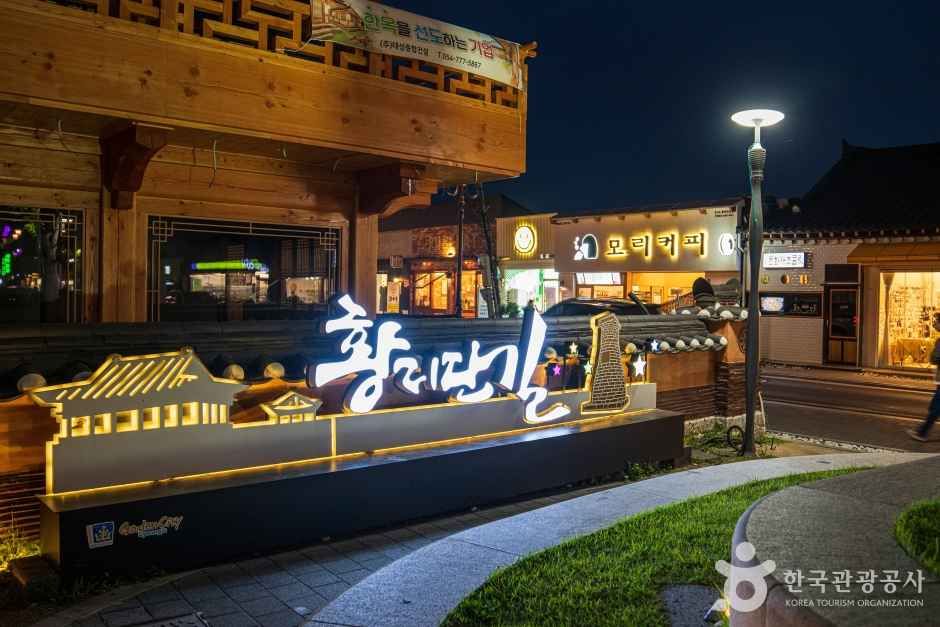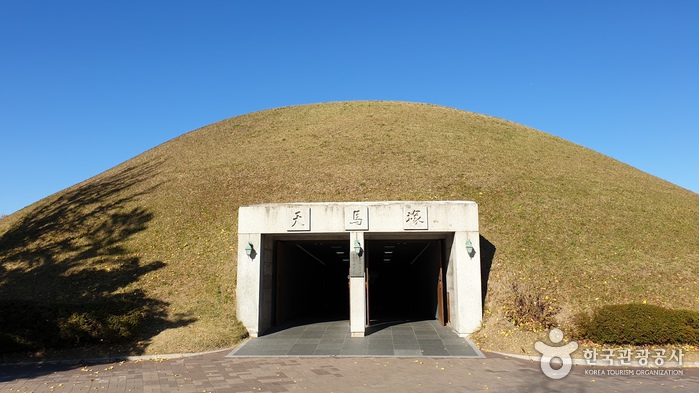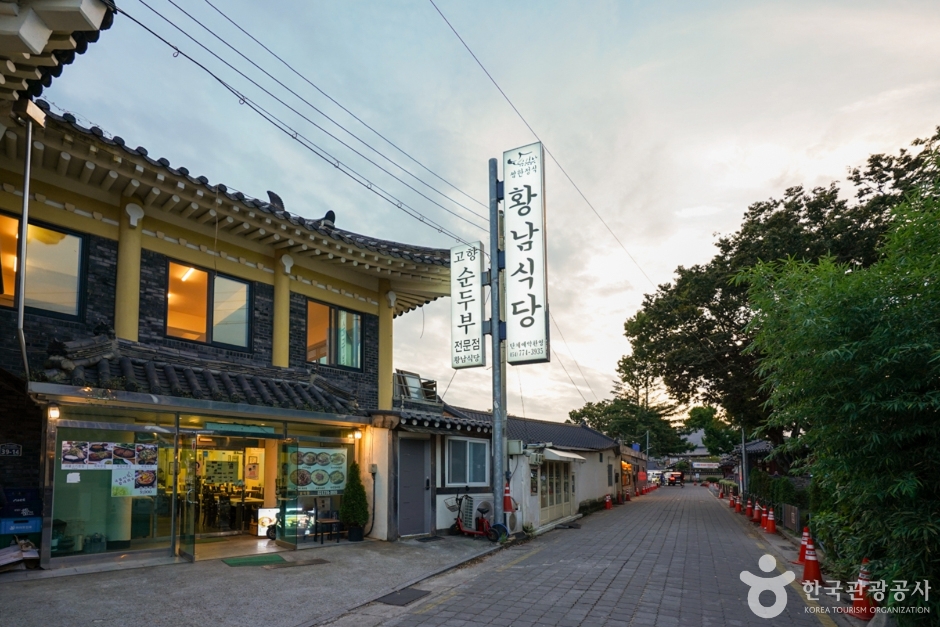Hanokinn [Korea Quality] / 한옥人(한옥인) [한국관광 품질인증/Korea Quality]
.0M 2023-04-13
19, Poseok-ro 1050beon-gil, Gyeongju-si, Gyeongsangbuk-do
This hanok (traditional Korean house) is located at the center of Hanok Conservation Area, known as Hwangnidan-gil Street. To the north lies the old alley that connects to Cheomseongdae Observatory. The house has sarangchae building, byeolchae building, and main building, which is used as a gallery and café, surrounding the grass lawn in the center. All rooms are equipped with ondol (under-the-heating system) and a red clay finish, and each room has a bathroom with shower facilities.
Sarangchae is a two-story hanok building with a hipped-and-gable roof. Its first floor is occupied by a double room and a family room, which can support up to 4 people. Byeolchae is a single-floor hanok with a gable roof, containing two double rooms and a raised floor space. The main building’s gallery contains a hanok experience room, cafe, restaurant, and a traditional tea room. A Korean-style breakfast is offered in the cafe, and the management also offers experience programs like tea ceremony, traditional games like yunnori (board game), and traditional musical instruments like janggo (hourglass-shaped drums) and gayageum (twelve-stringed zither).
Boulangerie Jeongnyeon-ae: Pain Chaltbori et Tteok Chaltbori(천년애 경주빵 찰보리빵 찰보리떡)
242.4M 2025-04-02
67, Cheomseong-ro, Gyeongju, Gyeongsangbuk-do, Corée du Sud
Boulangerie Chunnyeonae: Pain Chaltbori et Tteok Chaltbori est située dans la rue Hwanglidan à Gyeongju. L'extérieur, construit en hanok, dégage une atmosphère traditionnelle et élégante. Les plats emblématiques de cet endroit sont le Tteok Chaltbori et le pain. Le Pain Chaltbori et le gâteau de riz utilisent 100 % de l'orge gluant, qui est cultivée à partir de semences semées à la mi-octobre et récoltée au début de juin de l'année suivante. Ils représentent des spécialités de Gyeongju. Étant un en-cas nutritif fabriqué à partir de l’orge gluant cultivée à Gyeongju, qui abrite les vestiges de l'histoire de Silla sur mille ans, ils sont reconnus comme un produit régional phare.
SOSEOLJAE [Korea Quality] / 소설재(첨성대점) [한국관광 품질인증]
282.4M 2021-04-01
46, Poseok-ro 1050beon-gil, Gyeongju-si, Gyeongsangbuk-do
+82-54-7357-7412
As a traditional Korean guesthouse with modern facilities but with some traditional features of a Korean house such as wooden floor and ceramic tiled roof intact, Soseoljae is located next to Cheomseongdae in Gyeongju. It also has an old well in the garden. Each guestroom is furnished with bathroom and air conditioner for the convenience of the guests. The single-story guesthouse has a total of 11 rooms that can accommodate 2-4 people depending on the size of the room. The two-story stand-alone guesthouse located right next to the main gate can accommodate six, and it has a small tea room. The guesthouse has a cafe at the entrance. It's conveniently located near Cheomseomdae, Daereungwon Ancient Tombs, and Hwangnyongsaji (Hwangnyongsa Temple Site) as well as Gyeongju Station and Gyeongju Express Bus Terminal.
Rue Hwanglidangil à Gyeongju(경주 황리단길)
314.9M 2025-04-02
1080, Poseok-ro, Gyeongju, Gyeongsangbuk-do, (Hwangnam-dong)
La rue Hwanglidan-gil est la plus jeune de Gyeongju, son nom étant une combinaison de Hwangnam-dong et de Gyeongridan-gil, qui signifie "la rue Gyeongridan-gil de Hwangnam-dong". Elle s'étend de la croisée de Naenam à la croisée près de l'école élémentaire de Hwangnam, englobant les zones de Hwangnam-dong et de Sajung-dong des deux côtés de la route.<br>
Cette rue conserve des bâtiments anciens des années 1960 et 1970, permettant de ressentir l'atmosphère d'antan. Depuis quelques années, elle attire de plus en plus de jeunes, avec des cafés au bon ambiance, des boutiques de décorations originales, des magasins de souvenirs et des restaurants uniques. Au début, les magasins étaient concentrés le long de la route, mais avec l'extension de Hwanglidan-gil, des boutiques distinctes commencent à s'installer dans les ruelles.<br>
Elle est devenue un incontournable lors d'un voyage à Gyeongju, et permet de visiter des attractions voisines comme l'Observatoire de Cheomseongdae et Daereungwon, faisant de cet endroit un site touristique prisé.<br>
Hwangnamguan [Korea Quality] / 주식회사 황남관 [한국관광 품질인증]
406.8M 2023-04-13
1038, Poseok-ro, Gyeongju-si, Gyeongsangbuk-do
+82-10-3518-4582
Located in Gyeongju City, Hwangnamgwan is a traditional Korean style accommodation which opened in April 2014. The place looks like a small hanok village with 4 one-story buildings and 2 two-story buildings, constructed on about 5000㎡ of building site. The buildings are equipped with modern convenience facilities but manage to preserve the antique flavor of traditional Korean house. All rooms are equipped with a bathroom. A bathtub is installed in the largest room, Numaru Suite. Auxiliary facilities include the seminar room which is located in the two-story building. There are a cafe and a pizza restaurant on the first floor for meetings or simple meals. Guests are given discount coupons for the cafe.
Various traditional plays can be enjoyed in the hanok. It is possible to take photos with the beautiful Hwangnamgwan building in the background wearing traditional Korean clothes. You can also play Neolttwigi, Tuho, and Jegichagi in the wide yard and experience twisting legs, bastinado, turning the millstone, fulling, Pogurak (dancing play), etc. which have appeared on TV dramas. It is possible to receive discounted services at nearby affiliated facilities: 50% discount at Spalux Jjimjilbang, Kids Cafe, and Sport Town Bowling Center. Famous tourist attractions such as Cheonmachong Tomb, Cheomseongdae Observatory, and Banwolseong Fortress are within walking distance; and the National Gyeongju Museum and Gyeongju World Culture Expo Park are likewise not far from Hwangnamgwan.
Zone historique de Gyeongju [Patrimoine mondial de l’UNESCO] (경주역사유적지구)
417.2M 2025-03-27
757, Taejong-ro, Gyeongju-si, Gyeongsangbuk-do
+82-54-779-6100
La zone historique de Gyeongju, enregistrée au patrimoine culturel mondial de l’UNESCO en novembre 2000, personnifie l’histoire et la culture millénaires de Gyeongju, l’ancienne capitale du royaume de Silla (新羅, 57-935).
Cette zone peut être divisée en cinq grandes sections. La première, la zone de Namsan, renferme de véritables trésors de l’art bouddhiste qui datent de l’époque du royaume de Silla. Le Mont Namsan de Gyeongju, souvent décrit comme un musée à ciel ouvert, abrite de nombreux monuments historiques de la dynastie Silla, parmi lesquels Poseokjeong (site historique n° 1), Tapgok Maaejosanggun (trésor n° 201), la pagode de pierre de trois étages de Cheollyongsaji (trésor n° 1188), le Bouddha de pierre de Chilbulam Maae (trésor n° 200), la statue assise de Bouddha de Bulgok (Treasure No. 198), et 37 autres reliques du Bouddhisme.
La zone de Wolseong forme la seconde section, et marque l’emplacement d’un ancien palais du royaume de Silla. On y trouve Gyerim (site historique n°19), Imhaejeonji (site historique n° 18), qui est l’emplacement d’un palais royal de Silla, et le Cheomseongdae (trésor national n° 31), le plus vieil observatoire d’Asie. La troisième zone, celle de Daereungwon, accueille un groupement de tombes royales des rois et des reines de Silla. Non loin de là se trouvent entre autres un Gobungun (un ancien cimetière) à Nodong-ri (site historique n° 38), un autre Gobungun à Noseo-ri (site historique n° 39), un troisième Gobungun à Hwangnam-ri (site historique n° 40) et Oreung (site historique n° 172). Les archéologues ont découvert dans cette zone des reliques historiques inestimables, parmi lesquelle Geumgwan (une couronne d’or), Cheonmado (a une peinture de chevaux volants), et de nombreuses poteries. Ces trouvailles ont apporté de précieux renseignements sur la vie quotidienne du peuple vous la dynastie Silla.
La quatrième zone, celle de Hwangnyongsa, marque l’emplacement de l’ancien temple de Hwangnyongsa (site historique n° 246) et de la pagode de pierre de Bunhwangsa. Finalement, la zone de Sanseong abrite de nombreux vestiges des fortifications de la capitale. On y trouve la forteresse de Myeonghwalsanseong (site historique n°47), qu’on estime vieille de 400 ans environ.
La zone historique de Gyeongju possède au total 52 biens culturels désignés, enregistrés sur la liste du patrimoine culturel mondial.
[ Zone de Namsan(남산지구)(Site Historique) ]
- Bouddha sculpté dans la roche du temple de Borisa(보리사마애석불)(Bien culturel immatériel régional), Bouddha assis en pierre dans la vallée de Mireukgok du mont Namsan(미륵곡 석불좌상)(Trésor), Pagode en pierre à trois étages dans la vallée de Yongjangsa(용장사곡 삼층석탑)(Trésor)
- Bouddha assis sculpté dans la roche(석불좌상)(Trésor), Statue bouddhique en pierre du temple de Yonggansaji(용장사지 마애여래좌상)(Trésor), Pagode en pierre à trois étages de Cheonryongsaji(천룡사지 삼층석탑)(Trésor)
- Supports de mât de drapeau sur le site du temple de Namgansa(남간사지 당간지주)(Trésor), Puits en pierre du site de Namgansa(남간사지 석정)(Bien culturel immatériel régional), Pagode en pierre à trois étages de Namsan à Gyeongju(경주남산리 삼층석탑)(Trésor)
- Triade de Bouddhas debout en pierre de Bae-dong(경주배리 석불입상)(Trésor), Statue assise en pierre de Yuneulgok(윤을곡 마애불좌상)(Bien culturel immatériel régional), Trois tombes royales(삼릉)(Site Historique)
- Bouddha assis sculpté dans la vallée de Bulgok(불곡 석불좌상)(Trésor), Bodhisattva sculpté dans la roche au hermitage de Sinseonam(신선암 마애보살반가상)(Trésor), Bouddha sculpté dans la roche de Chilbulam(칠불암 마애석불)(Trésor)
- Groupe de statues en pierre de Tapgok(탑곡 마애조상군)(Trésor), Bouddha assis en pierre dans la vallée de Samneung du mont Namsan, Gyeongju(경주 남산 삼릉계 석조여래좌상)(Trésor)
- Statue de la bodhisattva Gwan-eum sculptée dans la roche dans la vallée de Samneung(삼릉계곡 마애관음보살상)(Bien culturel immatériel régional), Statue assise de Sakyamuni/Sage sculptée dans la roche dans la vallée de Samneung(삼릉계곡 마애 석가여래좌상/선각여래좌상)(Bien culturel immatériel régional)
- Six reliefs de Bouddha en linéaire dans la vallée de Samneung(삼릉계곡 선각 육존불)(Bien culturel immatériel régional), Tête de Bouddha en pierre d'Ipgok(입곡 석불두)(Bien culturel immatériel régional), Statue assise de Bouddha dans la vallée d'Erosion(침식곡 석불좌상)(Bien culturel immatériel régional)
- Statue assise en pierre de Yeolamgok(열암곡 석불좌상)(Bien culturel immatériel régional), Bouddha en relief dans la vallée de Yaksoo(약수계곡 마애입불상)(Bien culturel immatériel régional)
- Statue de Bouddha sculptée dans la roche au mont Baegun(백운대 마애석불입상)(Bien culturel immatériel régional), Site du pavillon de Poseokjeong(포석정지)(Site Historique), Forteresse de Namsan à Gyeongju(경주 남산성)(Site Historique), Étang de Seochulji(서출지)(Site Historique)
- Tombeau du roi Ilseong à Gyeongju(신라일성왕릉)(Site Historique), Tombeau du roi Jeonggang de Silla(신라정강왕릉)(Site Historique), Tombeau du roi Heongang de Silla(신라헌강왕릉)(Site Historique)
- Tombeau du roi Naemul de Silla(신라내물왕릉)(Site Historique), Tombeau du roi Jima de Silla(지마왕릉)(Site Historique), Tombeau du roi Gyeong-ae de Silla(경애왕릉)(Site Historique), Puits de Najeong à Gyeongju(경주나정)(Site Historique)
- Tabernacle en pierre à Namsan-dong, Gyeongju(경주남산동 석조감실) (Bien culturel immatériel régional)
[ Zone de Wolseong(월성지구) ]
Gyelim(계림)(Site Historique), Wolseong à Gyeongju(경주 월성)(Site Historique), Donggung et Wolji(동궁과 월지)(Site Historique), Cheomseongdae(첨성대)(Trésor)
Zone de Gyelim et Wolseong du tombeau de Naemul(내물왕릉계림월성지대)(Site Historique et traçage)
[ Zone de Daereungwon(대릉원지구)]
Tombeau de Michu(미추왕릉)(Site Historique), Zone de Daereungwon à Gyeongju(경주 대릉원 일원)(Site Historique), Oryeong(오릉)(Site Historique)
Zone archéologique à l'est(동부사적지대)(Site Historique), Puits de Jaemaejeong(재매정)(Site Historique)
[ Zone de Hwangnyongsa(황룡사지구)]
Site de Hwangnyongsa à Gyeongju(경주 황룡사지)(Site Historique), Pagode en briques de pierre du temple de Bunhwangsa(경주 분황사 모전석탑) (Trésor)
[ Zone de Sanseong(산성지구) ]
Forteresse de Myeonghwal à Gyeongju(경주 명활성)(Site Historique)
Daereungwon (Tombe Cheonmachong) (대릉원 (천마총))
432.2M 2023-01-25
9, Gyerim-ro, Gyeongju-si, Gyeongsangbuk-do
+82-54-750-8650
De grandes tombes anciennes des rois et de la noblesse de la dynastie Silla peuvent être visitées aux alentours de la ville de Gyeongju, notamment dans le parc Daereungwon. Vous trouverez dans ce lieu vingt-trois grandes tombes ainsi que les tombes anciennes les plus fameuses du pays, dont la tombe Cheonmachong et la tombe Hwangnamdaechong. Lors des fouilles pratiquées dans cette région durant les années 1970, la tombe Cheonmachong a été découverte avec une peinture d’une selle de cheval d’où son nom ('ma' signifie cheval en coréen). Cette peinture est la seule de la dynastie Silla à avoir été découverte. Vous pouvez également entrer et visiter l’intérieur de la tombe Cheonmachong. On compte 11.526 reliques et couronnes du roi à l’intérieur de la tombe, montrant le style de vie luxueux du roi. La tombe Hwangnamdaechong est l'autre grande attraction touristique du lieu, il s'agit là de la plus grande tombe ancienne. Elle abrite les corps du roi et de la reine et plus de 30 milliers de reliques et de bijoux en or. Il est à noter également à propos de la tombe Hwangnamdaechong que la tombe de la reine possède le plus d'accessoires de luxe. De là, les chercheurs ont conclu que même la reine pouvait avoir une position sociale très élevée même avant de se marier. Lors de votre visite, vous pourrez faire la découverte de la culture ancienne de la Corée, une culture de plus de 1 500 ans.
Rue Ssam-bap de Gyeongju(경주 쌈밥거리)
485.9M 2025-04-02
9, Gyerim-ro, Gyeongju, Gyeongsangbuk-do, Corée du Sud
La ville de Gyeongju, riche en patrimoine culturel brillant de Silla, peut être décrite comme un véritable site historique. C'est aussi une région célèbre pour sa gastronomie. Elle abrite de nombreux quartiers réputés, comme ceux de Hwangnam-bbang, de la soupe de récupération coréenne(haejangguk), du bulgogi et de la soupe de poisson épicée(maeuntang). En particulier, la zone autour de Daereungwon est renommée pour ses ruelles de ssam-bap. Le plat principal, le ssam-bap, est servi avec des accompagnements copieux, y compris du poisson savoureux et de la viande, ainsi qu'un jjigae de sauce de soja préparé avec du doenjang fait maison, et une sélection fraîche et variée de légumes à envelopper. Chaque restaurant propose une variété de menus, tels que des ssam-bap avec bulgogi grillé et du bulgogi de boeuf.
Voyage nocturne à Gyeongju 경주야행 (외국어사이트용)
596.0M 2017-04-18
Gyeongsangbuk-do, Gyeongju-si, Gyochon-gil 31-11
Gyeongju Soohojeong [Korea Quality] / 경주수호정 [한국관광 품질인증]
601.9M 2020-09-08
15-15, Poseok-ro 1068beon-gil, Gyeongju-si, Gyeongsangbuk-do
+82-10-2379-7248
Gyeongju Suhojeong, located in front of the Gyeongju Daereungwon, is a Hanok guesthouse in a ㄱ shape. The traditional house was built in 2015 in accordance with traditional architecture using natural materials such as pine tree, red clay, straw, and others; thus, it is cool in summer and warm in winter. Planted along the wall next to the door are Korean hornbeams, top trees, maple trees, and elm trees. The climbing roses on the wall bloom in May and offer a great sight. The spacious yard with a stone table is a great place to chat with fellow guests. There are seven rooms in total and a cafeteria which doubles as a lounge. Each room with a bathroom has modern facilities that suit traditional beauty. Gyeongju Station and Gyeongju Intercity Bus Terminal are only five minutes away on foot, making the trip to the guesthouse by public transport easy. Sitting right next to the Hwangridangil Street, the accommodation offers great access to popular restaurants and fashion places of Gyeongju, and to major tourist attractions such as Daereungwon, Cheomseongdae, Balwolseong, Anjapji, and Gyochon Village.
![Hanokinn [Korea Quality] / 한옥人(한옥인) [한국관광 품질인증/Korea Quality]](http://tong.visitkorea.or.kr/cms/resource/65/2707565_image2_1.jpg)

![SOSEOLJAE [Korea Quality] / 소설재(첨성대점) [한국관광 품질인증]](http://tong.visitkorea.or.kr/cms/resource/61/2530261_image2_1.jpg)

![Hwangnamguan [Korea Quality] / 주식회사 황남관 [한국관광 품질인증]](http://tong.visitkorea.or.kr/cms/resource/06/2635706_image2_1.jpg)
![Zone historique de Gyeongju [Patrimoine mondial de l’UNESCO] (경주역사유적지구)](http://tong.visitkorea.or.kr/cms/resource/83/202783_image2_1.jpg)


![Gyeongju Soohojeong [Korea Quality] / 경주수호정 [한국관광 품질인증]](http://tong.visitkorea.or.kr/cms/resource/11/2635611_image2_1.jpg)
 Français
Français
 한국어
한국어 English
English 日本語
日本語 中文(简体)
中文(简体) Deutsch
Deutsch Español
Español Русский
Русский